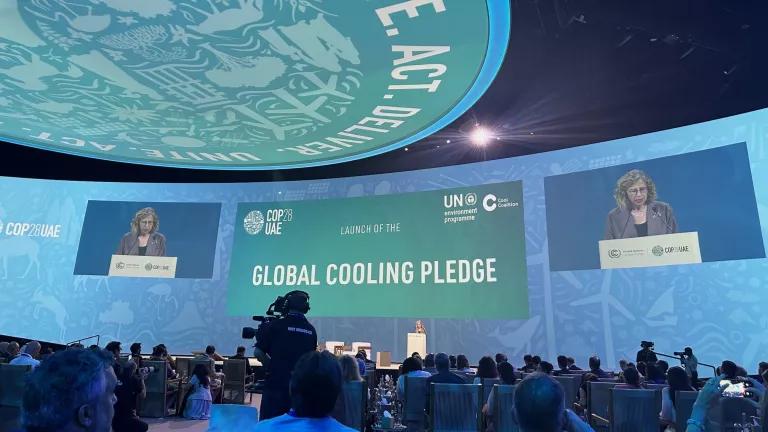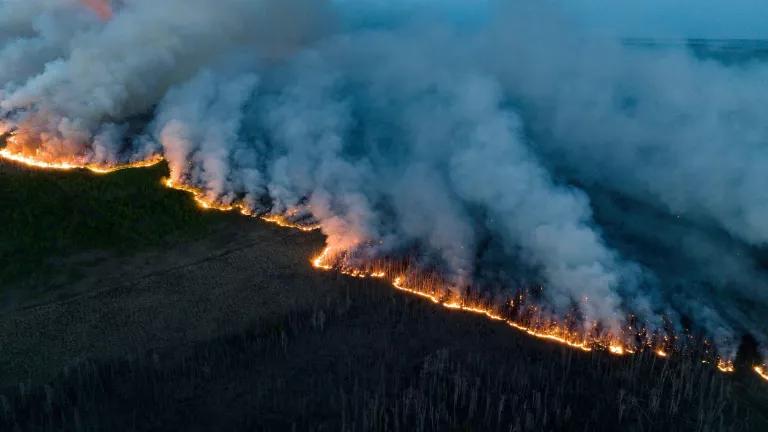Building Resilience, BRIC by BRIC: Fall 2022 Update
In this post, we’ll take a look at this year’s national competition selections, compare them to last year’s outcomes, and discuss some changes FEMA is making to the program.
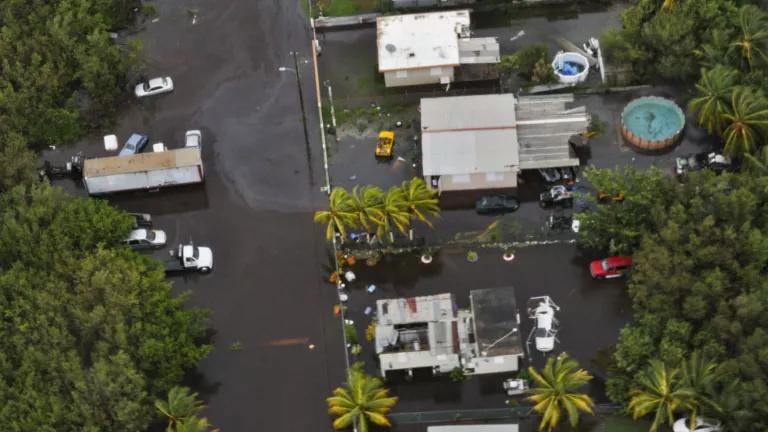
An aircrew from Coast Guard Air Station Borinquen conduct an overflight of Puerto Rico in the aftermath of Hurricane Fiona in September 2022.
Once again, climate-charged disasters have demonstrated the critical importance of investing in adaptation and resilience. In the span of just a few days earlier this month, Hurricane Fiona knocked out power and water for millions of Puerto Ricans while Typhoon Merbok devastated coastal communities in Western Alaska. And now, as I write this, the National Hurricane Center is predicting that Hurricane Ian will bring up to 10 feet of storm surge to western Florida.
FEMA’s Building Resilient Infrastruture and Communites (BRIC) grant program is intended to help communities reduce risks from events like these. But last year, after FEMA announced the program’s first round of grant selections, advocates and community leaders criticized the agency for allocating funding mostly to higher-capacity states and localities. This year's selections demonstrate steps in the right direction, but improvements are still needed.
As I wrote in my July Building Resilience, BRIC by BRIC: Summer 2022 Update, FEMA took a phased approach to this year’s grant selections: Round 1 (announced in May) covered the state and territory allocations, tribal set-aside, and non-financial technical assistance, while Round 2 (announced in August) covers the larger, individual projects in the “national competition.”
For a refresher on the program, check out my original Building Resilience, BRIC by BRIC post from September 2021. In this post, we’ll take a look at this year’s national competition selections, compare them to last year’s outcomes, and discuss some changes FEMA is making to the program.
Before we get started, here are a couple of quick terminology reminders. FEMA refers to these funding announcements as “selections” because they aren’t final yet: some additional review and administrative work is needed before FEMA officially awards the grants. Also, remember that most BRIC funding is awarded via the states and territories, who are the official “applicants” to FEMA. The cities, counties, and other local entities seeking funding submit “subapplications” through their state or territorial governments. For simplicity, I’ll refer to those subapplications as “projects.”
Overview of Project Selections
This year, a total of $1 billion was available in BRIC funding, double the amount from the previous year. (Next year, it will rise again, to $2.3 billion.) The national competition project selections and associated management costs accounted for a full 80% of that $1 billion total, up from the previous year’s 75%. In other words, an even larger share of the overall funding is going to capital projects relative to planning, project scoping, and other capacity-building efforts.
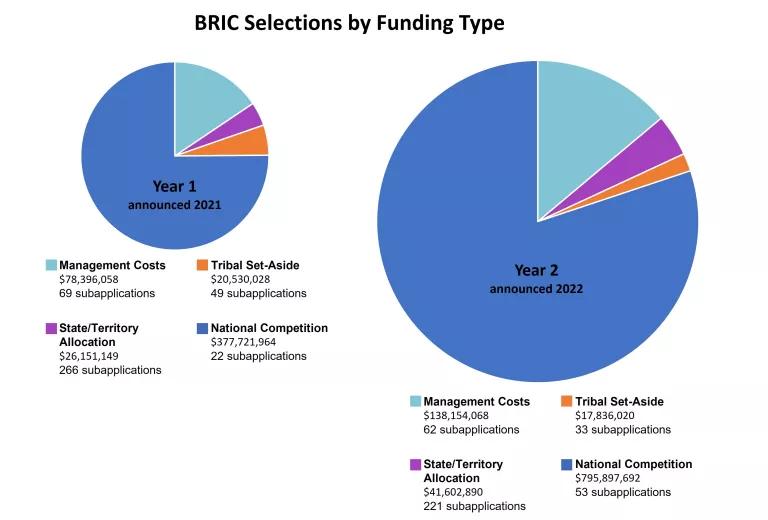
The four categories of BRIC funding are the national competition, the state/territory allocation, the tribal set-aside, and management costs.
Similar to the previous grant cycle, this year the national competition selections represent a relatively small number of mostly very large, expensive projects. FEMA selected 53 projects under the national competition, with an average grant amount of over $15 million. Four of those projects are on track to receive the maximum BRIC award of $50 million.
Despite the increased tribal set-aside (FEMA made an additional $5 million available this year) there were actually fewer selected tribal projects, accounting for only $17 million of the possible $25 million. FEMA’s data show an increased number of ineligible tribal applications, for example because the proposed projects didn’t meet program requirements or the applications were incomplete. Unused funding from the tribal set-aside is reallocated to the national competition, effectively meaning that funding redistributed from smaller or capacity-focused projects in tribal communities to larger, construction-focused projects in higher-capacity states.
Distribution of Project Funding
As with last year, this year's public project information from FEMA does not include specific locations for most of the BRIC selections, so once again I took on the task of determining the county where each project is located. With some help from my colleagues, I was able to assign counties to 90% of the subapplications from the national competition and 60% from other funding categories. (Some subapplications are for statewide activities or for projects spanning multiple counties, and others’ locations couldn’t be determined based on the project name.) This allows us to take a more detailed look at where the selected projects are located—and not located.
The map below shows the locations of projects selected during the national competition. The circles are sized proportionally to the amount of FEMA funding requested. (This includes only the “federal share,” excluding any state/local match or any other funding sources, so the cost of the full project may be larger.)
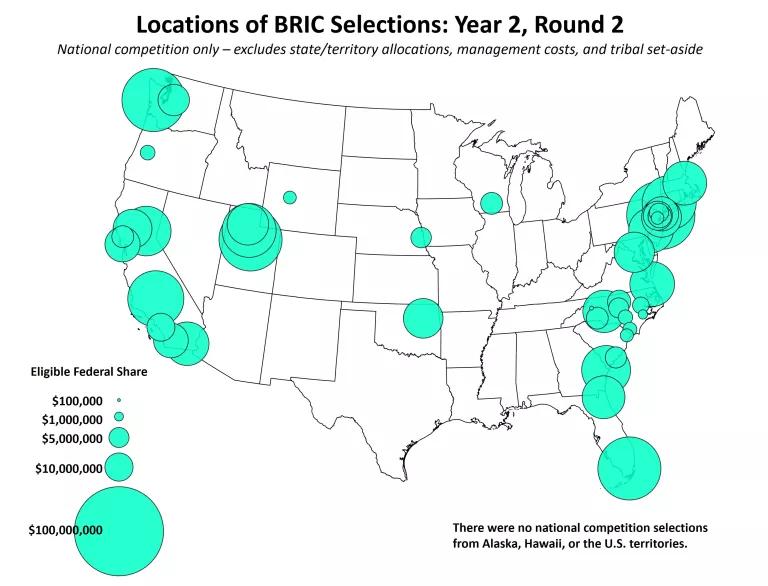
The 53 projects selected from the national competition are located in 19 states. Locations are approximate.
In BRIC’s first year, the 22 selected projects from the national competition only represented 10 states, primarily in coastal areas. This year, several more states had successful subapplications, including Nebraska, Oklahoma, Utah, Wisconsin, and Wyoming. However, coastal states and states with strong building codes still dominate the selections, with California alone accounting for nearly a quarter of the national competition’s funding.
FEMA only published project amounts for successful subapplications this year, so we can’t create a direct comparison to last year’s maps of successful/unsuccessful and eligible/ineligible projects. We can, however, map the approximate locations of the unselected subapplications, as shown below.
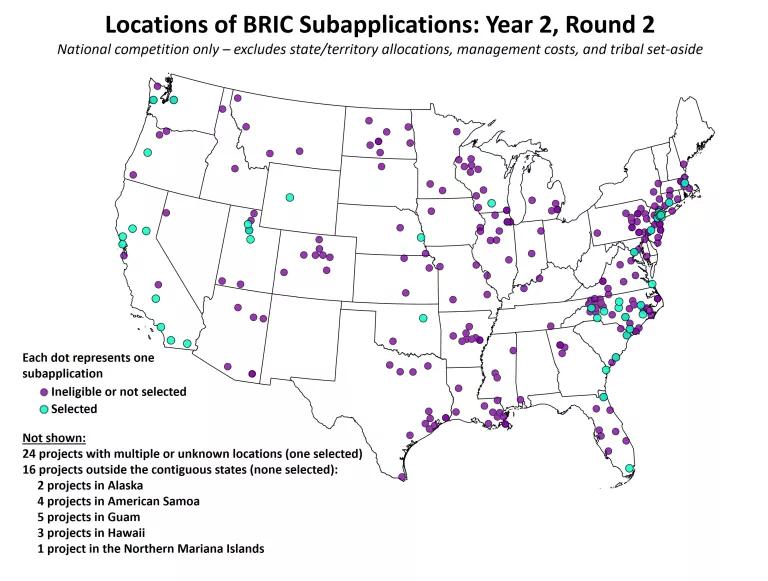
A total of 28 states and territories applied under the national competition but had no successful projects. Locations are approximate.
Last year, we reported that selected projects tended to be more expensive, with higher non-federal cost shares. The data aren't available to compare this year’s results, but the selected projects still tend to be located in counties that have high expected annual losses according to FEMA’s National Risk Index. They also tend to be located in counties with lower social vulnerability, as well as higher capacity (as measured by Headwaters Economics’ Rural Capacity Index)—and, importantly, this trend is also true of projects that aren’t selected. This means that BRIC subapplications tend to be from areas with more expensive assets at risk, higher-capacity local government, and fewer socially vulnerable communities, compared to the nation as a whole.
However, there is some positive news. The median social vulnerability score among counties with selected projects did increase (suggesting that more vulnerable areas are receiving a larger share of funding). FEMA also reported that 46% of the selected projects met one or more of the Justice40 interim criteria. In addition, FEMA has updated the program’s evaluation criteria to include a broader, social vulnerability-based definition of a disadvantaged community, in addition to the very narrowly defined Economically Disadvantaged Rural Community designation that leaves out any community with more than 3,000 residents.
State building codes remain an important component of the BRIC scoring criteria. Last year, all of the selected projects were in places with strong statewide building codes (or citywide, in the case of Washington, D.C.). You might remember that an audience member in a FEMA webinar even asked if applying for BRIC was a “lost cause” for communities in states without current building codes. This year, Wisconsin and Wyoming both had successful projects despite the states not qualifying for any building code points. However, states like Illinois, Texas, and Colorado that also lack statewide building codes still did not see any of their projects selected.
Nature-Based Solutions
Nature-based solutions are important components of climate adaptation and resilience. FEMA’s guidance defines them as “sustainable planning, design, environmental management, and engineering practices that weave natural features or processes into the built environment to build more resilient communities.” Common examples of nature-based solutions include living shorelines, rainwater bioretention systems, and restoration of floodplains, wetlands, and dunes.
BRIC’s technical criteria awards 10 points to projects that incorporate nature-based solutions, out of a maximum point score of 115. Last year, FEMA reported that 18 of the 22 selected projects in the national competition received these points. This year, FEMA’s website indicates that a lower proportion of competitive selections—21 of 53—include nature-based solutions.
However, under FEMA’s “all or nothing” approach, all subapplications that incorporate nature-based solutions receive the same 10 points, regardless of the scale or scope of the project’s nature-based components. That means a project that has a small nature-based component receives the same points as a fully nature-based project. As a result, it’s difficult to determine how much BRIC funding is truly supporting nature-based solutions. Some of the projects, like the Chestnut Bay constructed wetland in Conway, South Carolina, clearly have nature-based solutions at their core. Others appear to be multi-part projects that have some nature-based components ranging from substantial to modest or even minimal. Ascertaining the true extent of each project’s nature-based elements is made more difficult by their limited narrative descriptions as well as the inconsistencies between those descriptions and FEMA’s categorical project “tags.”
We recommend that FEMA provide more detail on the nature-based components of each project so that the public can better understand which projects include such elements and what proportion of the overall project cost will support nature-based solutions.
Project Eligibility
Each funding category—the national competition, the state/territory allocation, the tribal set-aside, and management costs—had a higher percentage of ineligible subapplications compared to last year. In the national competition, FEMA determined that 35% of subapplications did not meet program requirements, compared to 21% last year. As shown in the map below, some states saw a majority—or all—of their project submissions deemed ineligible.
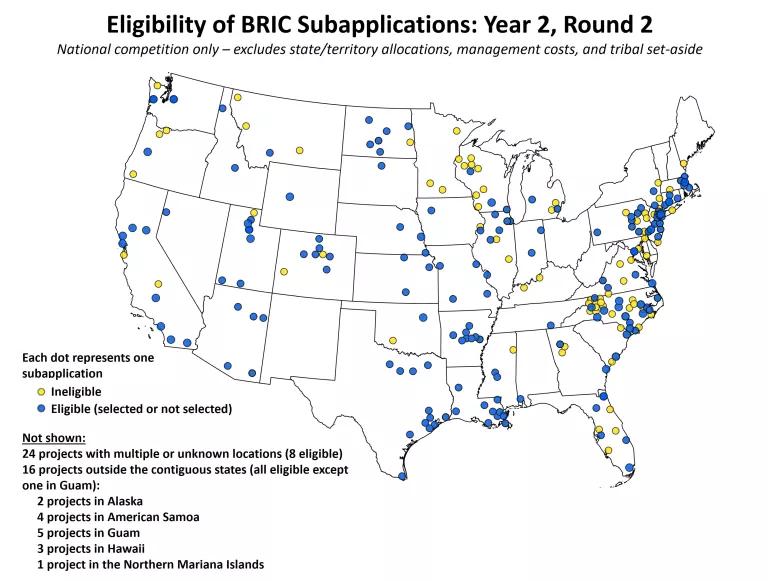
FEMA determined that 35% of the subapplications in the national competition were ineligible. Locations are approximate.
High ineligibility rates suggest that capacity gaps are not just a concern at the local level, but at the state level as well. Because local governments can’t apply directly for BRIC funding, states are ultimately responsible for the quality of application packages. States play an important role in building local capacity for hazard mitigation, but the support they can provide is often determined by their own level of capacity and commitment to adaptation and resilience.
Looking Ahead
Last year, we provided a number of policy recommendations to help FEMA to improve the BRIC program. FEMA has taken positive steps to better prioritize low-income communities and communities of color in its scoring criteria. As I described in my Round 1 blog post, increased funding levels also meant more support for capacity building efforts, and FEMA committed to provide non-financial technical assistance to more communities.
The next Notice of Funding Opportunity for BRIC, for the program’s third year, includes some additional updates that should help make BRIC funding more accessible, including allowing eligible (sub)applicants to apply on behalf of an Economically Disadvantaged Rural Community. FEMA also plans to assist socially vulnerable communities in developing their benefit-cost analyses, a required application component that can pose a substantial burden on applicants.
As we look ahead to future grant cycles, we urge FEMA (and Congress, where necessary) to continue working to improve the BRIC program. Our recommendations include:
- Creating a dedicated set-aside for capacity building activities, particularly for low-income communities, communities of color, and tribal communities.
- Creating a dedicated set-aside for nature-based solutions and publishing more detailed data on nature-based project components.
- Allowing high-priority capability and capacity-building activities to be funded under the national competition, and incentivizing these activities via scoring and/or cost share.
- Allowing nonprofits/community-based organizations to apply for BRIC funds on behalf of low-capacity communities.
- Making building code adoption an eligible activity for the national competition as well as the state/territory allocation and tribal set-aside.
Here at NRDC, our thoughts are with everyone affected by the recent storms and those to come. All communities deserve the resources and capacity needed to address climate risks and thrive in the face of increasing hazards. With continued improvements, FEMA can ensure that the BRIC program is a more accessible, equitable, and effective part of the solution.


